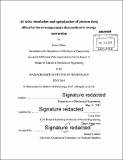| dc.contributor.advisor | Gang Chen. | en_US |
| dc.contributor.author | Zhou, Jiawei | en_US |
| dc.contributor.other | Massachusetts Institute of Technology. Department of Mechanical Engineering. | en_US |
| dc.date.accessioned | 2015-12-03T20:52:39Z | |
| dc.date.available | 2015-12-03T20:52:39Z | |
| dc.date.copyright | 2015 | en_US |
| dc.date.issued | 2015 | en_US |
| dc.identifier.uri | http://hdl.handle.net/1721.1/100088 | |
| dc.description | Thesis: S.M., Massachusetts Institute of Technology, Department of Mechanical Engineering, 2015. | en_US |
| dc.description | Cataloged from PDF version of thesis. | en_US |
| dc.description | Includes bibliographical references (pages 81-85). | en_US |
| dc.description.abstract | In recent years, extensive efforts have been devoted to searching for materials with high thermoelectric (TE) efficiency above room temperature for converting heat into electricity. These efforts have led to significant advances with a record-high zT above 2. However, the pursuit of higher TE performance at lower temperatures for cooling and refrigeration applications receives much less attention. Today's most widely-used thermoelectric materials below room temperature are still (Bi,Sb) 2(Te,Se)3 material system, discovered 60 years ago with a maximum zT around 1. This thesis develops the first-principles simulation tools to study the phonon drag effect - a coupling phenomenon between electrons and non-equilibrium phonons - that leads to a large Seebeck coefficient at low temperatures. Phonon drag effect is simulated successfully from first-principles for the first time and results compare well with experimental data on silicon. While the common wisdom always connects a significant phonon drag effect to a high thermal conductivity, a key insight revealed from the simulation is that phonons contributing to phonon drag and to thermal conductivity do not spectrally overlap. Even in a heavily-doped silicon sample with 1019 cm-3 doping concentration, phonon drag still contributes to -50% of the total Seebeck coefficient. By selectively scattering phonons contributing to heat conduction but not to phonon drag, a large improvement in thermoelectric figure of merit zT is possible. An ideal phonon filter is shown to tremendously enhance zT of n-type silicon at room temperature by a factor of 20 to ~0.25, and the enhancement reaches 70 times at lOOK. A practical phonon filtering method based on nanocluster scattering is shown to enhance zT due to reduced thermal conductivity and optimized phonon drag effect. This work opens up a new venue towards better themoelectrics by harnessing non-equilibrium phonons. More material systems can be systematically studied with the developed simulation tools. | en_US |
| dc.description.statementofresponsibility | by Jiawei Zhou. | en_US |
| dc.format.extent | 85 pages | en_US |
| dc.language.iso | eng | en_US |
| dc.publisher | Massachusetts Institute of Technology | en_US |
| dc.rights | M.I.T. theses are protected by copyright. They may be viewed from this source for any purpose, but reproduction or distribution in any format is prohibited without written permission. See provided URL for inquiries about permission. | en_US |
| dc.rights.uri | http://dspace.mit.edu/handle/1721.1/7582 | en_US |
| dc.subject | Mechanical Engineering. | en_US |
| dc.title | Ab initio simulation and optimization of phonon drag effect for lower-temperature thermoelectric energy | en_US |
| dc.type | Thesis | en_US |
| dc.description.degree | S.M. | en_US |
| dc.contributor.department | Massachusetts Institute of Technology. Department of Mechanical Engineering | |
| dc.identifier.oclc | 928960442 | en_US |
